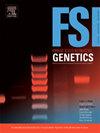Using an interaction timeline to investigate factors related to shedder status
IF 3.1
2区 医学
Q2 GENETICS & HEREDITY
引用次数: 0
Abstract
A major factor that influences DNA transfer is the propensity of individuals to ‘shed’ DNA, commonly referred to as their ‘shedder status’. In this work we provide a novel method to analyse and interrogate DNA transfer data from a largely uncontrolled study that tracks the movements and actions of a group of individuals over the course of an hour. By setting up a model that provides a simplistic description of the world, parameters within the model that represent properties of interest can be iteratively refined until the model can sufficiently describe a set of final DNA observations. Because the model describing reality can be constructed and parametrised in any desired configuration, aspects that may be difficult to traditionally test together can be investigated. To that end, we use a 60-min timeline of activity between four individuals and use DNA profiling results from objects taken at the conclusion of the hour to investigate factors that may affect shedder status. We simultaneously consider factors of: the amount of DNA transferred per contact, the rate of self-DNA regeneration, the capacity of hands to hold DNA, and the rate of non-self-DNA removal, all of which may ultimately contribute to someone’s shedder status.
使用交互时间轴调查与脱壳状态相关的因素。
影响DNA转移的一个主要因素是个体“脱落”DNA的倾向,通常被称为他们的“脱落状态”。在这项工作中,我们提供了一种新的方法来分析和询问DNA转移数据,这些数据来自一项很大程度上不受控制的研究,该研究跟踪了一组个体在一小时内的运动和行为。通过建立一个提供对世界的简单描述的模型,模型中表示感兴趣的属性的参数可以迭代地改进,直到模型能够充分描述一组最终的DNA观察结果。由于描述现实的模型可以在任何期望的配置中构造和参数化,因此可以对传统上难以一起测试的方面进行调查。为此,我们使用四个人之间的活动60分钟的时间线,并使用DNA分析结果,在一个小时的结论采取的对象,以调查可能影响脱落状态的因素。我们同时考虑了以下因素:每次接触转移的DNA量,自我DNA再生的速度,手持有DNA的能力,以及非自我DNA去除的速度,所有这些都可能最终导致某人的脱毛状态。
本文章由计算机程序翻译,如有差异,请以英文原文为准。
求助全文
约1分钟内获得全文
求助全文
来源期刊
CiteScore
7.50
自引率
32.30%
发文量
132
审稿时长
11.3 weeks
期刊介绍:
Forensic Science International: Genetics is the premier journal in the field of Forensic Genetics. This branch of Forensic Science can be defined as the application of genetics to human and non-human material (in the sense of a science with the purpose of studying inherited characteristics for the analysis of inter- and intra-specific variations in populations) for the resolution of legal conflicts.
The scope of the journal includes:
Forensic applications of human polymorphism.
Testing of paternity and other family relationships, immigration cases, typing of biological stains and tissues from criminal casework, identification of human remains by DNA testing methodologies.
Description of human polymorphisms of forensic interest, with special interest in DNA polymorphisms.
Autosomal DNA polymorphisms, mini- and microsatellites (or short tandem repeats, STRs), single nucleotide polymorphisms (SNPs), X and Y chromosome polymorphisms, mtDNA polymorphisms, and any other type of DNA variation with potential forensic applications.
Non-human DNA polymorphisms for crime scene investigation.
Population genetics of human polymorphisms of forensic interest.
Population data, especially from DNA polymorphisms of interest for the solution of forensic problems.
DNA typing methodologies and strategies.
Biostatistical methods in forensic genetics.
Evaluation of DNA evidence in forensic problems (such as paternity or immigration cases, criminal casework, identification), classical and new statistical approaches.
Standards in forensic genetics.
Recommendations of regulatory bodies concerning methods, markers, interpretation or strategies or proposals for procedural or technical standards.
Quality control.
Quality control and quality assurance strategies, proficiency testing for DNA typing methodologies.
Criminal DNA databases.
Technical, legal and statistical issues.
General ethical and legal issues related to forensic genetics.

 求助内容:
求助内容: 应助结果提醒方式:
应助结果提醒方式:


